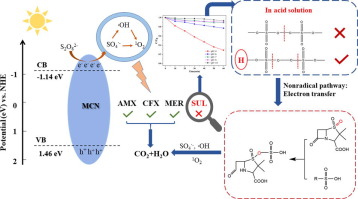Chemical Engineering Journal ( IF 15.1 ) Pub Date : 2020-04-06 , DOI: 10.1016/j.cej.2020.124899 Mengmeng Dou , Jin Wang , Boru Gao , Zhaokun Ma , Xue Huang

|
The degradation characteristics of four typical structures of β-lactam antibiotics were studied during the synergistic oxidation mechanism of persulfate (PS) and mesoporous g-C3N4 (MCN) under visible light irradiation including amoxicillin (AMX), cefotaxime (CFX), meropenem (MER), and sulbactam (SUL). Notably, the degradation of SUL in the MCN/PS system exhibits a pH-dependence different from the other three antibiotics. In this work, a novel oxidation channel for such persistent organic pollutant was revealed. Initially, SUL was bound specifically with PS via the addition reaction caused by the electron transfer between the oxygen atoms of the sulfoxide group of SUL and the HSO3- group generated by the protonation of PS. The reaction was carried out under acidic conditions and generated the SUL-O-SO2H byproducts. Successively, the adduct was further oxidized by the free radicals and singlet oxygen until the intermediate products were completely mineralized. The environmental factors of the reaction, such as the presence of humic acid and the cation-anion interactions, were also considered. In this work, the degradation pathways of SUL, the hydrolysis of the β-lactam ring, the decarboxylation, and the deamination reaction based on the combination of DFT calculations and the HPLC-QTOF-MS/MS analysis are elucidated. The toxicity of the byproducts was also calculated via the USEPA TEST. The findings improve the understanding of the reaction mechanism of the persulfate and the photocatalytic systems and provide new ideas for the oxidative degradation of refractory organic contaminants.
中文翻译:

新型难降解β-内酰胺类抗生素在可见光下过硫酸盐与gC 3 N 4协同作用的新型原位化学氧化通道-pH依赖性
研究了过硫酸盐(PS)和中孔gC 3 N 4(MCN)在可见光照射下协同氧化机理中四种典型结构的β-内酰胺类抗生素的降解特性,包括阿莫西林(AMX),头孢噻肟(CFX),美罗培南( MER)和舒巴坦(SUL)。值得注意的是,MCN / PS系统中SUL的降解表现出与其他三种抗生素不同的pH依赖性。在这项工作中,揭示了这种持久性有机污染物的新型氧化通道。最初,SUL通过SUL亚砜基的氧原子与HSO 3-之间的电子转移引起的加成反应,与PS特异性结合。由PS的质子化产生的基团。反应在酸性条件下进行,生成SUL-O-SO 2。H副产物。依次,加合物被自由基和单线态氧进一步氧化,直到中间产物完全矿化。还考虑了反应的环境因素,例如腐殖酸的存在和阳离子与阴离子的相互作用。在这项工作中,阐明了基于DFT计算和HPLC-QTOF-MS / MS分析相结合的SUL的降解途径,β-内酰胺环的水解,脱羧和脱氨基反应。还通过USEPA TEST计算了副产物的毒性。这些发现增进了对过硫酸盐和光催化体系反应机理的理解,并为难降解有机污染物的氧化降解提供了新思路。


























 京公网安备 11010802027423号
京公网安备 11010802027423号